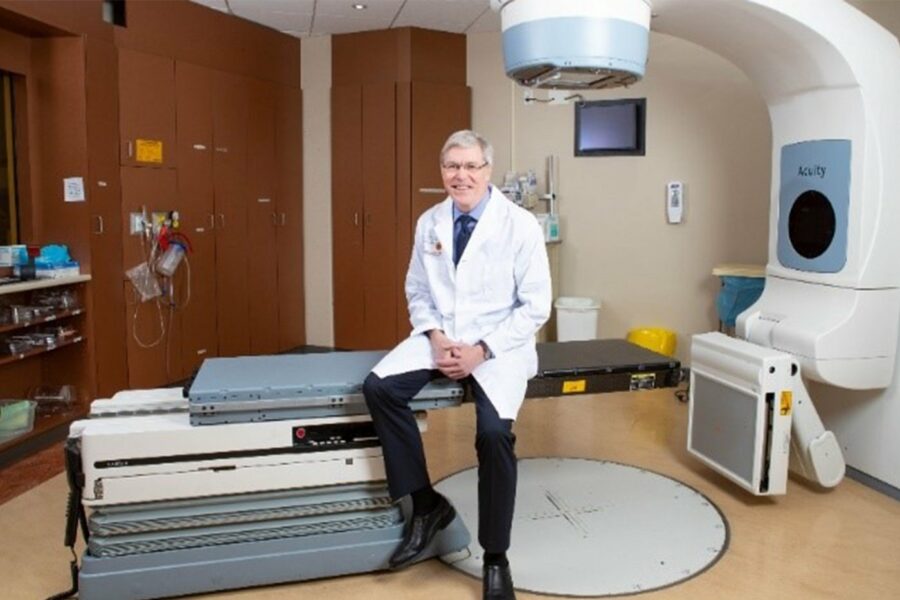
Improving radiation treatment accuracy through technology
- Anonymous
- 09 Feb 2020
Located on the Hamilton mountain, Juravinski Cancer Centre (JCC) provides many integral health care services to those across Southern Ontario. It is one of the 14 regional cancer programs in Ontario to ensure cancer care is delivered according to quality standards.
According to hamiltonhealth.ca, approximately 4,500 new radiation therapy cases are treated annually at the JCC. Radiation therapy is a precise treatment plan that uses radiation to target cancer cells. The JCC houses a large radiation treatment program with a team of radiation oncologists (physicians), radiation therapists, medical physicists, nurses, and several support staff.
A patient’s radiation treatment journey typically starts with an initial consultation following by three main steps. First, the radiation oncologist will explain the side-effects associated with radiation treatment and the preparation needed; for example, some patients may need to have a full bladder for treatment.
Secondly, the patient then has a planning session at the computed tomography (CT) simulator. This is used to gather reference anatomical data in order to create a map, which is then used to determine how the radiation will be delivered. An optimal treatment position that is simple and reproducible, like lying on your back or on your stomach, is established in CT.
Lastly, once all planning and quality assurance procedures are completed, the patient will start treatment. The treatment duration and frequency can vary; one patient can have daily treatments for 25 consecutive weekdays, while another patient can have three treatments spread over four weeks. The treatment position will be the same as that determined at the CT simulator. When the radiation is on, the patient will not feel anything.
With technological advancement, many techniques are used to ensure that patients receive accurate and precise treatment. This means that the radiation is only reaching areas the doctor has prescribed to treat, and that there is zero or minimal radiation reaching areas the doctor does not want to treat. Since radiation is known to have side effects, it is important to make sure that the side-effects are controlled. Next are a few examples of how technology has helped improve treatment delivery.
Deep Inspiration Breath Hold (DIBH)
Deep inspiration breath hold (DIBH) is when patients hold their breath during treatments. This technique is beneficial to patients receiving treatment to the breast or chest wall areas. By holding their breath during treatment, the patients are able to increase the distance between the heart and the chest wall. The extra margin minimizes the radiation dose reaching the heart. This can decrease the long-term side effects to the heart.
To track a patient’s breathing, a block is placed on the patient’s abdomen. The treatment machine and software are set up to track the block’s movement as the patient is breathing. When the treatment is ready to be delivered, patients will be instructed to take a slow deep breath in and hold; each radiation beam is on for about 30 seconds or less.
If the computer senses that the patient’s breath hold is not deep enough or is too deep, the beam will shut off and the treatment will not be delivered. Staff are continuously monitoring the patient’s breathing patterns to ensure that all treatments are delivered precisely and correctly.
Abdominal Compression
Patients receiving lung radiation therapy can benefit by wearing a special belt during their treatments. A lesion in the lung can move a lot especially when the patient is a heavy or deep breather. The tumour movement can also depend on where and if the tumour is attached to a bodily structure. A tumour that has a large range of motion during a patient’s normal breathing cycle is not encouraged. This is because the movement can cause the treatment area to receive too much or too little radiation. Too much radiation can cause more side-effects, whereas too little radiation renders the treatment ineffective.
The location and tightness of the belt, as well as tumour movement is determined in the planning CT session. If the tumour moves a lot when the patient is breathing, then a belt is placed over the patient’s abdomen for treatment. The belt is used as a compressor to make the patient’s breathing shallower. As the breathing becomes shallower, the tumour’s movement also decreases. The decrease in motion allows better-targeted radiation treatments.
Image Guidance (IGRT)
Medical imaging is also used to improve accurate radiation treatments. Immediately before each treatment, staff will take x-ray images and/or a low-dose CT scan. These images are used to evaluate the location of the patient’s anatomy. With the images immediately available on screen, staff would overlay the day’s images to the reference/planning CT images. The difference in the patient’s treatment position is evaluated in six different planes; longitudinal, vertical, lateral, pitch, roll, and rotation. Once the differences in position are calculated, the treatment couch will move the patient into the correct treatment position. The radiation treatment is then delivered.
The entire procedure from imaging to treatment can be as fast as 10 minutes. Back in the day, staff would have to run the x-ray film to develop in a dark room before treatment could be delivered, which meant the patient would have to be lying on the treatment table for over 30 minutes. Technological advancement has made radiation treatment not only more precise and accurate, but also timelier.
If you have any questions, please contact your family doctor or a walk-in clinic. For more information, please visit cancercareontario.ca and hamiltonhealthsciences.ca
Pictured in the lead photo is Dr. Timothy Whelan, a radiation oncologist at Hamilton Health Sciences’ Juravinski Cancer Centre, who was awarded the O. Harold Warwick Prize in 2019 for outstanding achievements in cancer control research. The award recognizes Dr. Whelan as a world leader in radiation therapy for breast cancer.
Comments 0
There are no comments


Add comment